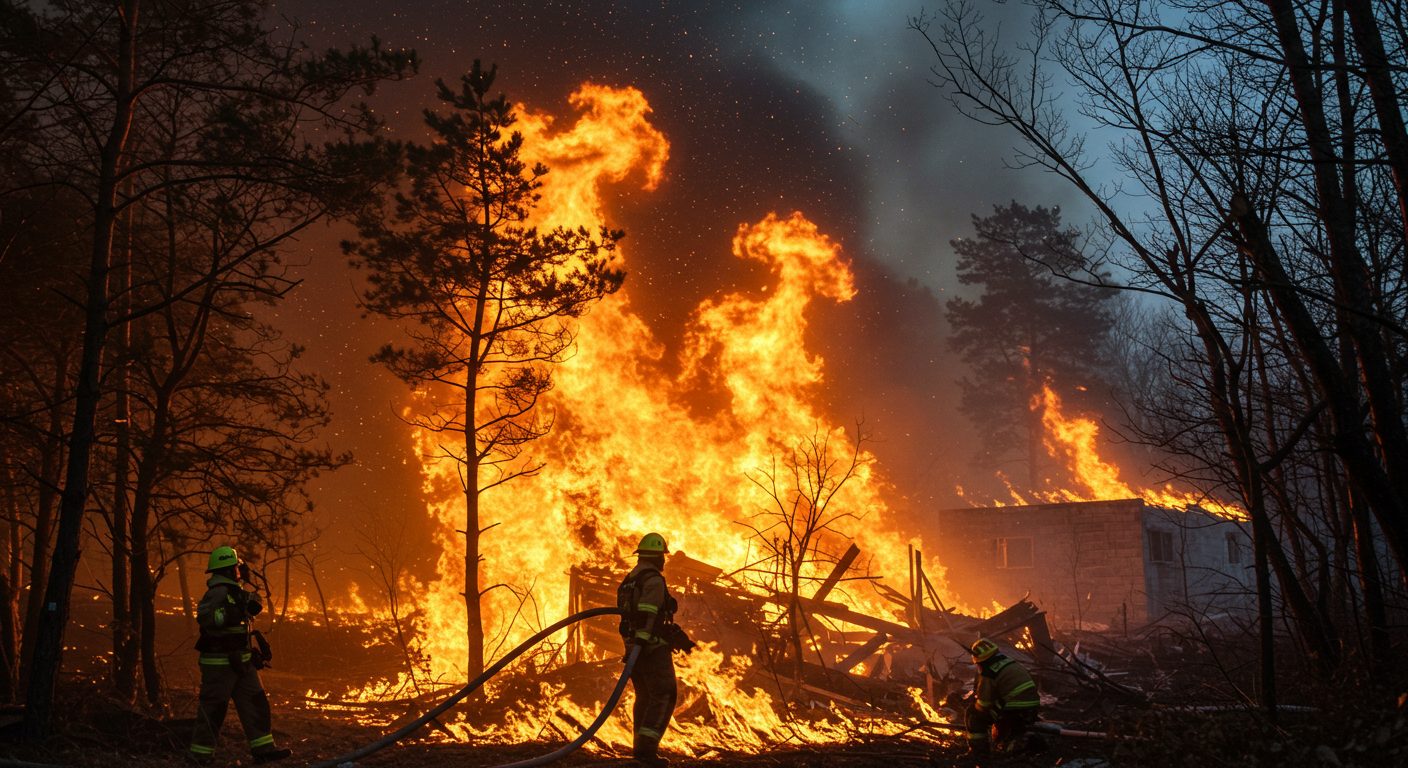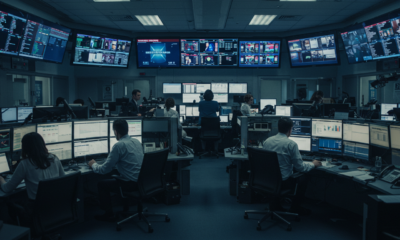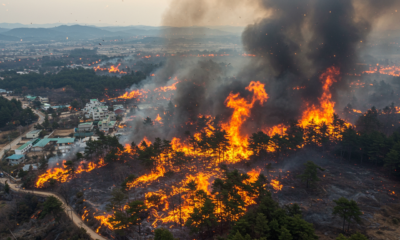NEWS
South Korea Battles Wildfire Crisis Today

South Korea is currently grappling with a devastating wildfire crisis that has engulfed vast areas of land, threatening lives, property, and the environment. The wildfire, which broke out earlier today, has spread rapidly due to strong winds and dry conditions, prompting emergency responses from local authorities, firefighters, and the military. This crisis has once again highlighted the vulnerability of the region to natural disasters and the urgent need for robust disaster management systems.
The Onset of the Wildfire
The wildfire was first reported in the early hours of the morning in a forested region of South Korea. Initial reports suggest that the fire may have been sparked by a combination of natural and human factors, though the exact cause is still under investigation. Dry weather, low humidity, and strong winds have created ideal conditions for the fire to spread quickly, making containment efforts extremely challenging.
Within hours, the flames had consumed hundreds of acres of forest, forcing residents in nearby towns and villages to evacuate. Thick plumes of smoke have blanketed the sky, reducing visibility and raising concerns about air quality in the affected regions. The South Korean government has declared a state of emergency in the area, mobilizing all available resources to combat the blaze.
Emergency Response Efforts
The South Korean government has activated its disaster response protocols, with firefighters, emergency medical teams, and military personnel working tirelessly to contain the wildfire. Helicopters and aircraft have been deployed to drop water and fire retardants on the affected areas, while ground teams are battling the flames on foot.
Local authorities have set up emergency shelters for displaced residents, providing food, water, and medical assistance. The government has also issued warnings to residents in nearby areas to remain vigilant and prepare for potential evacuations. Social media platforms and emergency alert systems are being used to keep the public informed about the latest developments.
Impact on Communities and Environment
The wildfire has had a profound impact on local communities, with many families losing their homes and livelihoods. Farmers and small business owners in the affected areas are facing significant losses, as the fire has destroyed crops, livestock, and infrastructure. The psychological toll on residents, many of whom have been forced to flee with little notice, cannot be overstated.
The environmental impact of the wildfire is equally concerning. South Korea’s forests are home to diverse ecosystems, and the destruction of these habitats could have long-term consequences for biodiversity. The fire has also released large amounts of carbon dioxide and other pollutants into the atmosphere, contributing to air pollution and climate change.
Challenges in Containing the Wildfire
Containing the wildfire has proven to be a daunting task for emergency responders. The rugged terrain of the affected region makes it difficult for ground teams to access certain areas, while strong winds continue to fuel the flames and push the fire in new directions. Firefighters are working around the clock, but the sheer scale of the blaze has stretched resources thin.
In addition to the physical challenges, the wildfire has also exposed gaps in South Korea’s disaster preparedness and response systems. While the country has made significant strides in recent years to improve its ability to handle natural disasters, this crisis has underscored the need for greater investment in firefighting equipment, training, and infrastructure.
Government and International Support
The South Korean government has pledged to provide full support to the affected communities, including financial assistance for rebuilding efforts. President Yoon Suk Yeol has expressed his condolences to those affected by the wildfire and vowed to do everything possible to bring the situation under control.
International support has also begun to pour in, with neighboring countries offering assistance in the form of firefighting equipment, personnel, and financial aid. The global community has recognized the severity of the crisis and the need for collective action to address the growing threat of wildfires in the region.
The Role of Climate Change
Wildfires are not uncommon in South Korea, but experts warn climate change worsens their frequency and intensity. Rising temperatures, prolonged droughts, and shifting weather patterns create ideal conditions for fires. Consequently, this crisis highlights the urgent need to address climate change and its impacts.
Therefore, South Korea must take proactive steps to mitigate these effects. First, it should invest in sustainable land management practices. Additionally, enhancing early warning systems is crucial. Moreover, promoting public awareness about fire prevention and safety is essential.
Furthermore, building resilience against future disasters is vital. For instance, adopting advanced technologies can help. Similarly, community training programs can prepare residents. Likewise, international cooperation can provide valuable support.
In contrast, ignoring these measures risks greater damage. However, taking action now can reduce future threats. Ultimately, South Korea must act decisively to combat climate change. By doing so, it can protect lives, property, and the environment. In summary, the time to act is now.
Lessons Learned and the Path Forward
The ongoing wildfire crisis in South Korea offers several important lessons for disaster management and preparedness. First and foremost, it highlights the importance of swift and coordinated action in the face of natural disasters. Effective communication between government agencies, emergency responders, and the public is critical to minimizing the impact of such events.
Second, the crisis underscores the need for greater investment in disaster preparedness and response capabilities. This includes not only firefighting equipment and infrastructure but also training programs for emergency personnel and community-based initiatives to promote fire safety.
Finally, the wildfire serves as a wake-up call for the global community to take collective action against climate change. The increasing frequency and severity of natural disasters around the world are a clear indication that the time to act is now. Governments, businesses, and individuals must work together to reduce greenhouse gas emissions, protect natural ecosystems, and build a more sustainable future.
Conclusion
South Korea fights a devastating wildfire, showcasing the resilience and determination of its people. Emergency responders and volunteers work tirelessly to protect lives, property, and the environment. Neighbors help neighbors, and strangers offer support, bringing communities together in crisis. The immediate focus remains on containing the fire and aiding affected residents.
Long-term efforts must address the root causes of wildfires, including climate change. Building a resilient society is essential to handle future challenges. South Korea must invest in better disaster management, sustainable practices, and public awareness.
Despite the adversity, the nation rises above the flames, determined to emerge stronger. Lessons from this crisis will shape future climate action and disaster preparedness. For now, South Korea stands united, ready to overcome this challenge and rebuild what was lost. The spirit of unity and resilience shines brightly in the face of disaster.
ENTERTAINMENT
Election Truth Alliance: Examining Claims of Electoral Integrity and Reform

Following the highly disputed 2020 U.S. presidential election, several organizations arose questioning the outcome’s validity, including the Election Truth Alliance (electiontruthalliance.org). This group has since become a prominent figure in the election integrity movement, claiming to uncover fraud, irregularities, and systemic flaws in America’s electoral processes. However, their allegations have generated significant controversy.
On one hand, supporters consider the Alliance an essential guardian of electoral transparency, while on the other, opponents label it as a source of disproven conspiracy theories. To properly evaluate these competing perspectives, we must examine the organization’s background, core arguments, supporting evidence, and overall influence on election policy debates. Additionally, we should consider how its claims compare with verified facts from election officials and independent experts. Furthermore, the group’s impact extends beyond mere rhetoric, potentially affecting voter confidence and legislative changes. Ultimately, understanding the Election Truth Alliance requires balanced analysis of both its stated mission and the factual basis for its claims. This examination proves particularly relevant as election integrity remains a polarizing issue in American politics.
1. Origins and Mission of the Election Truth Alliance
Founding and Background
The Election Truth Alliance (ETA) was established shortly after the 2020 election, a race that saw unprecedented disputes over mail-in ballots, voting machines, and alleged fraud. The group presents itself as a nonpartisan organization dedicated to:
- Investigating election anomalies
- Advocating for stricter voter ID laws
- Opposing mass mail-in voting
- Auditing electronic voting systems
ETA’s website features whistleblower testimonies, statistical analyses, and documentary-style reports alleging systemic vulnerabilities in U.S. elections. However, its ties to prominent election skeptics have raised concerns about its neutrality.
Key Figures and Affiliations
The Alliance does not publicly list its leadership, but investigations reveal connections to:
- Former Trump administration officials
- Conservative election integrity activists
- Groups that promoted “Stop the Steal” rhetoric
This has led critics to argue that ETA is politically motivated rather than an impartial truth-seeking entity.
2. Key Claims and Controversies
A. Allegations of Widespread Fraud
ETA has repeatedly claimed that millions of fraudulent ballots influenced recent elections. Its primary arguments include:
1. “Anomalous” Vote Counts in Swing States
- The group highlights unexpected vote spikes in Pennsylvania, Georgia, and Arizona.
- Claims that algorithmic manipulation or ballot stuffing caused irregularities.
Counterarguments:
- Multiple recounts and audits (including GOP-led reviews) found no evidence of mass fraud.
- The “spikes” align with legitimate mail-in ballot processing times.
2. “Dead Voters” on Registration Rolls
- ETA alleges that thousands of deceased individuals were recorded as voting.
Counterarguments:
- Investigations show most cases were clerical errors (e.g., a son with the same name as his deceased father voting).
- No evidence of widespread fraud from deceased voters.
3. Chain of Custody Issues with Mail Ballots
- ETA argues that unsecured drop boxes and unverified signatures enabled fraud.
Counterarguments:
- Bipartisan election officials confirm mail-in ballot security measures (barcodes, signature verification).
- Studies show fraud rates remain extremely low (0.00006% in 2020, per Heritage Foundation).
B. Voting Machine Vulnerabilities
ETA has heavily criticized Dominion and ES&S voting systems, claiming:
- Machines were connected to the internet (designed to be air-gapped).
- “Glitches” flipped votes in key races.
- 2000 Mules documentary (alleging ballot trafficking) as proof.
Counterarguments:
- Cybersecurity experts (including Trump’s DHS) found no evidence of hacking.
- “Glitches” were isolated and corrected (human error, not fraud).
- 2000 Mules was debunked by AP, Reuters, and Georgia’s GOP Secretary of State.
C. Opposition to Mail-In Voting
ETA argues that universal mail voting invites fraud through:
- Ballot harvesting (third-party collection).
- Lack of ID verification.
Counterarguments:
- Military and overseas voters rely on mail ballots.
- States with all-mail voting (e.g., Colorado, Oregon) have no higher fraud rates.
3. Influence on Election Reform Debates
Despite skepticism from experts, ETA has shaped election laws in GOP-led states:
A. Stricter Voter ID Laws
- Georgia, Texas, and Florida now require additional identification for mail ballots.
B. Ban on Ballot Drop Boxes
- Wisconsin and Florida restricted drop boxes, citing “security concerns.”
C. Voter Roll Purges
- Aggressive removals of “inactive” voters, which critics say disproportionately affect minorities.
Critics Argue:
- These measures suppress turnout without improving security.
- No evidence supports claims of mass fraud justifying such laws.
4. Media and Fact-Checking Response
- Mainstream outlets (CNN, NYT) label ETA as “election misinformation.”
- Fact-checkers (AP, Snopes, Politifact) have debunked its key claims.
- Social media platforms have restricted ETA-linked content for violating misinformation policies.
5. Conclusion: Does ETA Advance Election Integrity?
The Election Truth Alliance has brought attention to several legitimate election administration issues that warrant consideration, particularly regarding outdated voter registration systems and transparency in ballot counting processes. However, when examining their more dramatic allegations of widespread fraud, the claims consistently fail to hold up under rigorous scrutiny. While the organization positions itself as a nonpartisan watchdog, its most sensational assertions about stolen elections and compromised voting machines have been repeatedly debunked by election officials, courts, and independent fact-checkers across the political spectrum.
That being said, the concerns raised by the Alliance have undoubtedly influenced the national conversation about election security. In response to these discussions, numerous states have implemented stricter voting laws over the past few years, including enhanced voter ID requirements and limitations on mail-in voting. Proponents argue these measures are necessary safeguards, while critics contend they may disproportionately affect certain voter demographics without meaningfully improving election integrity. The debate continues as researchers study the actual impacts of these policy changes on both election security and voter participation.
What remains clear is that while some administrative vulnerabilities in election systems do exist – such as occasional errors in voter rolls or inconsistencies in ballot verification procedures – there is no evidence supporting claims of fraud occurring at a scale that could overturn election results. Moving forward, the challenge for policymakers will be to address legitimate concerns about election administration without undermining public confidence in the democratic process or creating unnecessary barriers to voting. A balanced approach that combines reasonable security measures with expanded access to voting might offer the most productive path toward restoring trust in elections while preserving every citizen’s right to participate.
For now, the best path forward may be bipartisan election reforms—not conspiracy theories—to restore trust in democracy.
NEWS
scoopupdates .com: Redefining Timely and Trusted News Delivery

In today’s rapidly evolving digital world, information is no longer measured solely by speed or quantity. The most impactful platforms are those that combine timeliness with accuracy, insight, and community relevance. One such emerging force is scoopupdates .com, a platform recognized for its ability to align cutting-edge news delivery with reader trust and engagement.
This article explores the journey of scoopupdates .com, its approach to blending real-time updates with reliable reporting, and why it represents the next generation of online news sources redefining success.
What Is scoopupdates .com?
scoopupdates .com has been steadily gaining recognition as a go-to destination for readers seeking breaking news, thoughtful analysis, and trending updates across multiple sectors. While its coverage spans politics, technology, business, entertainment, and lifestyle, what sets it apart is its holistic view of digital reporting: success is not just about being first, but about being right, relevant, and responsible.
The platform represents a growing movement of digital publishers who believe that speed and accuracy are not mutually exclusive but mutually reinforcing.
A Philosophy Rooted in Accuracy and Reader Trust
At the heart of scoopupdates .com is a commitment to accurate, trustworthy, and reader-focused reporting. This philosophy emphasizes:
-
Fact-Checked News: Ensuring every story is sourced and verified before publication.
-
Context and Insight: Going beyond headlines to explain why a story matters.
-
Community Engagement: Creating a space where readers can discuss, share, and contribute to the news conversation.
This approach reflects the growing recognition that modern media outlets cannot operate in isolation—they are embedded in the communities and digital ecosystems they serve.
Bridging Speed with Substance
What makes scoopupdates .com especially noteworthy is its ability to merge timely reporting with substantive journalism. Examples of this approach include:
-
Breaking News with Context: Delivering updates fast, but pairing them with expert perspectives or background details.
-
Thematic Coverage: Grouping stories around ongoing trends so readers can follow developments comprehensively.
-
Inclusive Story Selection: Highlighting voices and communities that are often overlooked in mainstream reporting.
By embedding these values into its work, scoopupdates .com illustrates how digital media can create a virtuous cycle—where credible reporting attracts a loyal audience, which in turn sustains quality journalism.
Influence in the Digital Age
As a rising news platform, scoopupdates .com understands the importance of digital presence and social media in today’s information economy. It embraces tools such as live updates, multimedia storytelling, and interactive features not just for visibility but to amplify conversations around critical issues.
This savvy use of digital tools enables it to:
-
Reach broader audiences with real-time news and engaging visuals.
-
Engage younger generations who value transparency, interactivity, and authentic reporting.
-
Inspire other outlets to integrate responsible, reader-focused approaches in their content strategies.
A Model for the Next Generation of News Platforms
scoopupdates .com’s rise reflects broader shifts in public expectations, particularly among Millennials and Gen Z. Today’s audiences increasingly look to media sources that embody:
-
Authenticity: Genuine alignment between stated values and actual practices.
-
Diversity and Inclusion: Commitment to representing varied communities and perspectives.
-
Global Awareness: Recognition of interconnected challenges, from climate change to economic inequality.
By championing these principles, scoopupdates .com has positioned itself as both a trailblazer and a trustworthy guide, showing readers how timely reporting can also be meaningful and impactful.
Key Features That Set scoopupdates .com Apart
-
Comprehensive Coverage
From breaking global headlines to niche topics, the platform’s wide-ranging sections ensure readers stay informed on issues that matter most to them. -
User-Friendly Experience
A clean, mobile-optimized layout allows for easy navigation, fast loading, and uninterrupted reading on any device. -
Multimedia Storytelling
Articles enhanced with images, videos, infographics, and data visualizations give readers multiple ways to engage with content. -
Community Interaction
Comment sections, polls, and newsletters enable readers to connect, share insights, and help shape coverage priorities.
Challenges and Opportunities for scoopupdates .com
Like any leader navigating today’s complex media landscape, scoopupdates .com faces challenges:
-
Balancing Speed and Verification: Ensuring news is accurate even as it’s breaking.
-
Standing Out in a Crowded Market: Differentiating itself from countless online news outlets.
-
Maintaining Reader Trust at Scale: Upholding high editorial standards as the platform grows.
Yet these challenges also present opportunities for innovation. scoopupdates .com’s adaptive mindset allows it to transform obstacles into catalysts for growth, ensuring that responsible reporting remains not just aspirational but practical.
Leveraging Technology for Reliable News
In the digital age, readers expect instant access without sacrificing credibility. scoopupdates .com delivers on both fronts by embracing cutting-edge technology:
-
Real-Time Alerts: Push notifications and newsletters keep readers informed of breaking stories.
-
AI-Assisted Curation: Smart algorithms help highlight the most relevant news for each reader.
-
Data Security: Safeguarding user information to build long-term trust.
By combining technology with a human-centered editorial approach, scoopupdates .com sets a new standard for modern news delivery.
Why scoopupdates .com Resonates with Readers Worldwide
News today is global, and scoopupdates .com reflects this reality by covering stories with international significance as well as local impact. Its balanced coverage welcomes readers from around the world to engage with news in a way that’s accessible, contextual, and trustworthy.
This global perspective not only broadens the platform’s reach but also underscores the interconnectedness of today’s news cycles—reminding readers that local events can have far-reaching implications.
Looking Ahead: The Future of scoopupdates .com
The future of scoopupdates .com looks bright as it continues to innovate, expand, and redefine what a digital news platform can be. In the coming years, the platform aims to:
-
Integrate more interactive features, such as live Q&As with journalists.
-
Expand its investigative and long-form content offerings.
-
Enhance personalization tools so readers can curate their own news dashboards.
These initiatives reflect a forward-thinking approach where speed, accuracy, and engagement converge.
Why scoopupdates .com Matters in Today’s Media Environment
In a world where misinformation spreads quickly and attention spans are short, scoopupdates .com provides a much-needed alternative. It represents a new generation of news outlets that value credibility, accessibility, and context as much as timeliness.
Whether you’re a busy professional who wants quick updates or a curious reader seeking deep analysis, scoopupdates .com offers the tools, stories, and community you need to stay informed and empowered.
Conclusion
As digital media continues to evolve, platforms like scoopupdates .com will lead the way in shaping how individuals consume and interact with news. By blending technology, responsible journalism, and community engagement, it sets a new standard for what readers can expect from trusted information sources.
In this new era, success in news delivery is about more than just speed—it’s about trust, context, and connection. scoopupdates .com embodies this shift, offering a blueprint for how modern news platforms can be both timely and reliable.
NEWS
South Korea Wildfires: 4 Fatalities Reported Amid 30 Blazes

South Korea is facing a catastrophic wildfire crisis as nearly 30 separate blazes erupted across the country, leaving at least four people dead and widespread destruction in their wake. The wildfires, fueled by strong winds and dry conditions, have forced thousands to evacuate, destroyed homes, and devastated vast areas of forest. This disaster has underscored the growing threat of wildfires in the region and the urgent need for enhanced disaster preparedness and climate action.
The Outbreak of the Wildfires
The wildfires began simultaneously in multiple regions, catching authorities and residents off guard. Reports indicate that the blazes started in the early hours of the morning, with dry vegetation and gusty winds causing the fires to spread rapidly. Within hours, the flames had engulfed forests, farmland, and residential areas, creating a scene of chaos and devastation.
The exact cause of the wildfires is still under investigation, but experts suggest that a combination of natural factors, such as prolonged drought and high temperatures, and human activities, such as unattended campfires or discarded cigarettes, may have contributed to the outbreak. The simultaneous ignition of 30 blazes has raised concerns about the possibility of coordinated arson, though no official confirmation has been made.
The Human Toll
Tragically, at least four people have lost their lives in the wildfires. Among the victims are elderly residents who were unable to evacuate in time and a firefighter who died while battling the flames. The loss of life has sent shockwaves through the nation, with many mourning the victims and expressing gratitude for the bravery of emergency responders.
Thousands of residents have been forced to flee their homes, seeking refuge in emergency shelters set up by local authorities. The sudden evacuations have left many families displaced, with little more than the clothes on their backs. The psychological impact of losing homes, livelihoods, and loved ones is immense, and mental health support services are being mobilized to assist those affected.
Emergency Response Efforts
The South Korean government has declared a state of emergency, mobilizing all available resources to combat the wildfires. Firefighters, military personnel, and volunteers are working around the clock to contain the blazes, often risking their lives to save others. Helicopters and aircraft have been deployed to drop water and fire retardants on the affected areas, while ground teams battle the flames on foot.
Despite their heroic efforts, emergency responders face significant challenges. The rugged terrain of some affected regions makes it difficult to access certain areas, and strong winds continue to fuel the fires, pushing them in unpredictable directions. The sheer scale of the disaster has stretched resources thin, prompting calls for additional support from neighboring countries and international organizations.
Environmental and Economic Impact
The wildfires have caused extensive damage to South Korea’s natural environment. Vast swathes of forest have been reduced to ash, threatening biodiversity and disrupting ecosystems. The loss of trees and vegetation will have long-term consequences for soil stability, water cycles, and air quality. The fires have also released large amounts of carbon dioxide and other pollutants into the atmosphere, contributing to climate change and posing health risks to residents.
The economic impact of the wildfires is equally severe. Farmers have lost crops and livestock, while small businesses have been destroyed, leaving many without a source of income. The cost of rebuilding homes, infrastructure, and communities will be substantial, and the government has pledged financial assistance to support recovery efforts.
The Role of Climate Change
While wildfires are not uncommon in South Korea, experts believe that climate change is exacerbating their frequency and intensity. Rising temperatures, prolonged droughts, and changing weather patterns have created conditions that are more conducive to the spread of fires. This crisis serves as a stark reminder of the urgent need to address climate change and its far-reaching impacts.
South Korea, like many other countries, must take proactive steps to mitigate the effects of climate change and build resilience against future disasters. This includes investing in sustainable land management practices, enhancing early warning systems, and promoting public awareness about fire prevention and safety. The government must also prioritize climate action, reducing greenhouse gas emissions and transitioning to renewable energy sources.
Lessons Learned and the Path Forward
The ongoing wildfire crisis in South Korea offers several important lessons for disaster management and preparedness. First and foremost, it highlights the importance of swift and coordinated action in the face of natural disasters. Effective communication between government agencies, emergency responders, and the public is critical to minimizing the impact of such events.
Second, the crisis underscores the need for greater investment in disaster preparedness and response capabilities. This includes not only firefighting equipment and infrastructure but also training programs for emergency personnel and community-based initiatives to promote fire safety. The government must also prioritize research and development to improve wildfire prediction and containment technologies.
Finally, the wildfire serves as a wake-up call for the global community to take collective action against climate change. The increasing frequency and severity of natural disasters around the world are a clear indication that the time to act is now. Governments, businesses, and individuals must work together to reduce greenhouse gas emissions, protect natural ecosystems, and build a more sustainable future.
Community Resilience and Solidarity
In the face of adversity, the resilience and solidarity of South Korea’s people have been remarkable. Communities have come together to support one another, with neighbors helping neighbors and strangers offering assistance to those in need. Volunteers have flocked to emergency shelters to provide food, water, and comfort to displaced residents, while donations of clothing, blankets, and other essentials have poured in from across the country.
The bravery and dedication of emergency responders have also been a source of inspiration. Firefighters, military personnel, and volunteers have risked their lives to protect others, working tirelessly to contain the blazes and save lives. Their efforts have not gone unnoticed, and the nation has come together to honor their courage and sacrifice.
Government and International Support
The South Korean government has pledged full support to the affected communities, including financial assistance for rebuilding efforts. President Yoon Suk Yeol has expressed his condolences to those affected by the wildfires and vowed to do everything possible to bring the situation under control. The government has also announced plans to review and strengthen its disaster management policies to better prepare for future crises.
International support has also begun to pour in, with neighboring countries offering assistance in the form of firefighting equipment, personnel, and financial aid. The global community has recognized the severity of the crisis and the need for collective action to address the growing threat of wildfires in the region.
Conclusion
South Korea battles a devastating wildfire crisis, showcasing resilience and determination. Emergency responders and volunteers tirelessly protect lives, property, and the environment. Communities unite, with neighbors helping neighbors and strangers offering support.
However, challenges remain immense. Strong winds and dry conditions fuel the flames, complicating containment efforts. Meanwhile, thousands evacuate, seeking safety in shelters.
Therefore, the immediate focus is on containing fires and aiding affected residents. Simultaneously, long-term efforts must address root causes, including climate change. For instance, sustainable land management and early warning systems are crucial. Additionally, public awareness about fire prevention must increase.
Consequently, South Korea must build a resilient society. Transitioning to renewable energy and reducing emissions are vital steps. Moreover, international cooperation can strengthen disaster response.
Ultimately, the nation rises above adversity, determined to rebuild. Lessons from this crisis will shape future policies. In conclusion, unity and action will guide South Korea toward recovery and resilience.
-

 NEWS4 months ago
NEWS4 months agoPolitical News: Key Global and Domestic Updates
-

 ENTERTAINMENT3 months ago
ENTERTAINMENT3 months agoTaylor Swift Crochet Dress: A Fashion Icon’s Handmade Style
-

 TECHNOLOGY2 months ago
TECHNOLOGY2 months agoUnraveling Orinpendex: Mysteries and Potential
-

 TECHNOLOGY4 months ago
TECHNOLOGY4 months agoRSSAwee: Unlocking the Future of Digital Connectivity
-

 TECHNOLOGY4 months ago
TECHNOLOGY4 months agoDGMNews.com: Revolutionizing Digital News in the Modern Era
-

 TECHNOLOGY4 months ago
TECHNOLOGY4 months agoUnveiling iamnobody89757: The Enigma of Digital Identity
-

 BLOG2 months ago
BLOG2 months agoUnraveling Iszlágiya: A Deep Dive into Its Essence
-

 HEALTH3 months ago
HEALTH3 months agoAIOTechnical.com: Innovating Health & Beauty with Advanced Tech


